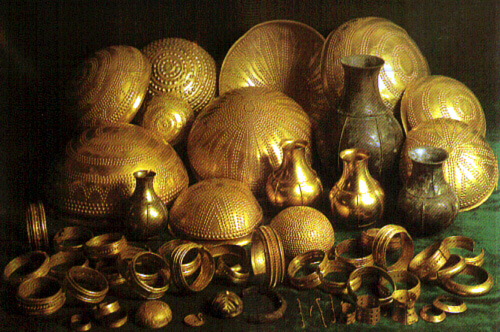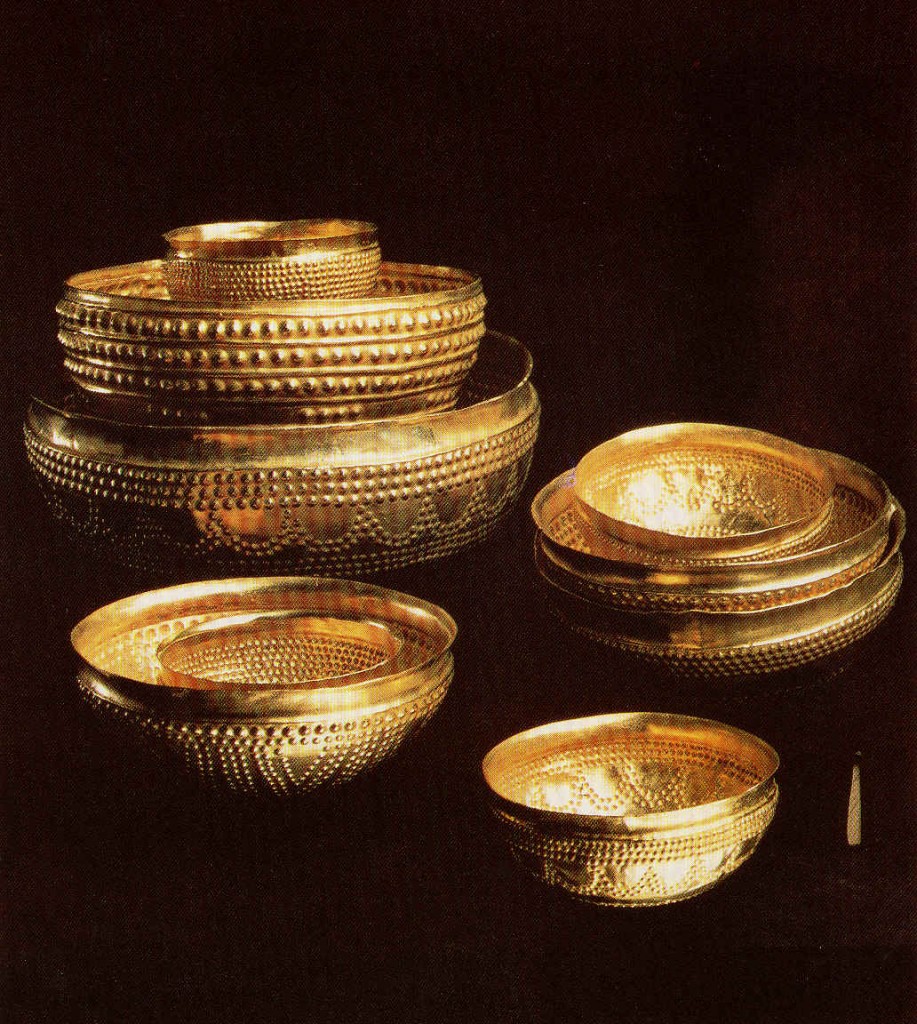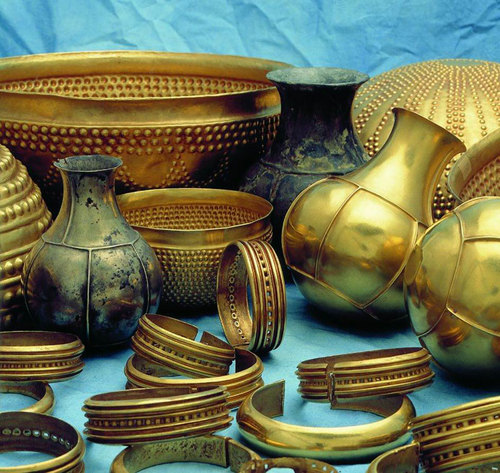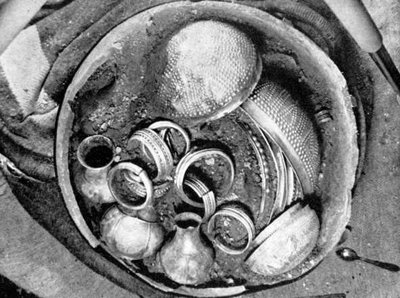A razzle-dazzle worth its weight in gold. A bracelet on a pretty Spanish arm once led archaeologists to an ancient trove of gold; a three thousand year old treasure which altered the entire concept of prehistoric civilization in western Europe. The treasure consists of bracelets, bowls and flagons, all of intricately worked pure gold; and one flagon of iron with gold overlay in unique in Europe. Nothing to compare with it had ever been found before. Most significant, the workmanship is distinctly western European, without any parallel whatsoever to the goldsmith’s art of the early Aegean civilizations with which it was contemporary.

Treasure of Villena. Among the most beautiful of the Villena treasures are a gold flagon, finely decorated bowls, an ornament with gold inlays, and four heavy bracelets.
A jeweler in the Spanish town of Villena spotted a bracelet on a young gypsy woman in 1963 and upon examining the heavy , elaborately incised armpiece more closely, he saw it was pure gold. He summoned the director of Villena’s museum of archaeology, Jose Maria Soler who told her that her husband had found it in some sand that was being used to mix concrete. A month later another gypsy woman was seen wearing a heavy gold bracelet….
She insisted it was a family treasure but when Soler examined her ”heirloom” he saw that like the other bracelet, it bore fresh traces of soil. Believing the gypsies had accidentally uncovered a prehistoric find, the archaeologist obtained legal permission to confiscate both pieces until their origin could be determined. Soon after, the husband of the second gypsy, a construction worker named Juan Calatayud, confessed he had found both while working a gravel quarry and volunteered to help the archaeologist.
Only six months earlier what is now called a ”little treasure” of gold objects had been unearthed by workers in a gypsum quarry on a hill known as Cabezo Redondo.Scattered deep in the chalky soil along with pottery sherds and other prehistoric remains, this find consisted of gold rings and bracelets, smaller but stylistically similar to those worn by the two gypsy women, and, most interesting of all; a number of unfinished pieces and a bar of unworked gold bearing the outline of a pattern. Surely, a goldsmith’s shop or factory had once stood there.
Soler began digging, and were ready to give up for the day when one of the men cried out a dusk that he had found another heavy gold bracelet which was soon followed by a huge pottery jar filled to the brim. Even in the swiftly fading light the glint of gold was dazzling. They dared not leave the spot. After building a bonfire for warmth, they sent for a photographer and more equipment to extricate the deeply buried vessel.
Back in Villena an inventory of the jar revealed an impressive haul: sixty eight separate pieces including five flagons, twenty-eight bracelets and two sword handles. The total weight of the gold treasure was over twenty-two pounds, the heaviest yet unearthed. One bracelet alone weighed more than a pound. The jar had been so skillfully packed that not an inch of space was wasted. This fact, plus the great depth suggests that it was a king’s treasure which had been buried for safekeeping. Evidence of fire in the soil around the spot indicated that a building once stood there, perhaps a royal palace which was set ablaze in the course of a battle.
The question is, what king? Soler theorized it was one of the petty rulers in southern Spain during the late Bronze Age and that, like other kings, he had his own private army and goldsmith. he must have lived in the same sort of splendor as the Mycenaean princes, or King Alcinous, who, according to Homer, ate from dishes of silver and gold. The golden bowls and flagons were probably royal tableware.
The kingdom of Tartessus reached its peak from the eighth to the sixth century B.C. but it was completely destroyed by invading Phoenicians and Carthaginians in the sixth century B.C. and to this day the site of its capital city has not been located. It was thought the Villena discovery belonged to an earlier Tartessus period despite the absence of geographic coherence between the regions.Also, the jewels of Tartessus were of ornate design while the Villena gold treasures a
xquisite but simple and predate the Tartessus jewels by at least 400 years, or 1000 B.C.Some have seen a likeness to later Celtic jewelry in the Villena treasure, and since the first wave of Celts reached southern Spain in the ninth century B.C. there has been some speculation that this might be the earliest representation of Celtic art. But, the Celts would have found an already established bronze age civilization here, and it is more likely that the roots of this culture go much further back, perhaps even to the unknown artists who sketched pictures of cattle herders, archers and dancing women on rock ledges in easter Spain some eight thousand years ago.
The search for more clues has of course been intensified. It is possible that future finds will uncover a uniquely Western civilization which developed in the Iberian Peninsula and remained totally independent of the Mycenaean and Egyptian cultures.







 COMMENTS
COMMENTS
Hi,
I’ve already read your post about the treasure of Villena. It has been a surprise finding a post written in english about that. I like how you tell the story because (I am from Villena) and I always hear the same story.
Well, that’s it. Good job. Bye.